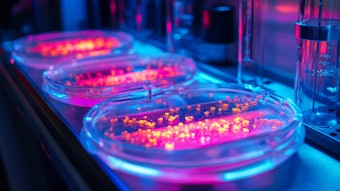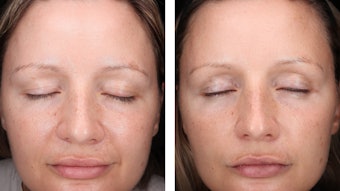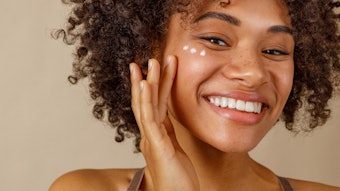Excessive exposure of the skin to UV and infrared (IR) rays leads to the formation of free radicals (FR) and degrades proteins in the skin’s extracellular matrix. These are the main causes of premature skin aging, as well as other skin diseases.1 The skin’s innate defense mechanism includes endogenous antioxidant molecules such as carotenes, vitamins, enzymes and other components.2 These molecules work actively by quenching FR. However, if the number of FR formed in the tissue increases significantly, the antioxidant defense system is unable to neutralize them. For this reason, additional antioxidants are essential to reinforce the skin’s own defenses through so-called biological sun protection.3
Log in to view the full article
Excessive exposure of the skin to UV and infrared (IR) rays leads to the formation of free radicals (FR) and degrades proteins in the skin’s extracellular matrix. These are the main causes of premature skin aging, as well as other skin diseases.1 The skin’s innate defense mechanism includes endogenous antioxidant molecules such as carotenes, vitamins, enzymes and other components.2 These molecules work actively by quenching FR. However, if the number of FR formed in the tissue increases significantly, the antioxidant defense system is unable to neutralize them. For this reason, additional antioxidants are essential to reinforce the skin’s own defenses through so-called biological sun protection.3
Supporting the skin with antioxidants can reduce the formation of FR. However, topical antioxidants have limited stability and, if not properly formulated, quickly lose their protective effects. Formulation strategies have been developed to address this instability, including new vehicles and novel packaging.4 In addition, encapsulation technologies improve the stability of these molecules. To obtain real efficacy, such technologies should deliver the molecules into targeted layers of the skin, where the FR are being formed.
In this study, the authors evaluated the effectiveness of a new smart lipid systema in stabilizing and delivering carotenes into the epidermis. The system is composed of different lipid aggregates, mainly smart discoidal structures and vesicles combined to maximize interactions with the skin through a biomimetic mechanism. The vesicles present in the system have a surface effect, improving superficial skin conditions, while the smart structures are able to modulate skin barrier function and pass through the narrow intercellular spaces of the stratum corneum (SC). Once inside, and via effects of internal skin conditions, e.g., water content, temperature and pH, these structures reassemble and increase in size, delivering their content and anchoring themselves between the skin layers for lasting action.5
Considering recent findings on the damage to skin collagen caused by the IR spectral range,6 a structural evaluation of the collagen in skin treated with the lipid-carotene system also was performed by small-angle x-ray scattering (SAXS) using synchrotron radiation. In addition, FR-scavenging effects were evaluated at different stages of UV exposure, and in a sun care formulation using electron paramagnetic resonance (EPR).7
Materials and Methods
The lipid-carotene system was prepared by dispersing the appropriate amounts of different lipids—mainly phospholipids—and carotenes in water. To compare the skin penetration of the new lipid-carotene system with a classical lipid delivery system, liposomes also were prepared using a mixture of phospholipids (INCI: Phosphatidylcholine) with the same concentration of carotene used in the new lipid-carotene system.
For the test substrate, full skin sections, 500 µm thick, were obtained from the back of Landrace large white pigs weighing around 60 kg. Skin was excised 15-30 min after the animal was sacrificed for medical testing following the U.S. National Institutes of Health’s (NIH) Guide for the Care and Use of Laboratory Animals. Skin samples were treated in vitro by applying 10 µL each of the lipid-carotene and liposome dispersions to 25 mm2 of skin. Some experiments also were conducted using a commercial SPF 50+ sunscreen.
For the irradiation steps described, the lipid-carotene system, and treated and untreated skin samples were subjected to electromagnetic radiation spectra from 310 nm to 800 nm, i.e., UVA and visible light. Irradiation was performed using a solar light simulatorb at 500 W/m2 for different periods of time, depending on the experiment. In a similar way, treated and untreated skin samples were submitted to IR radiation for 10 min, with a lampc; the lamp-to-sample distance was 10 cm.
Methods to characterize the lipid-carotene system involved the following:
Dynamic light scattering (DLS): The hydrodynamic diameter (HD) of the lipid-carotene system was measuredd to determine the size of the aggregates. A non-invasive backscattering technology was used to minimize scattering, and detection was performed at an angle of 173 degrees.
Cryo transmission electron microscopy (Cryo-TEM): Thin, aqueous films were formed by dipping bare specimen grids into the sample of the lipid-carotene system. These films were vitrified by plunging the grid into ethane using an automated systeme. The vitreous sample films were then transferred to a microscopef using a cryo-transfer apparatusg. Visualization was performed at 200 kV at a temperature between -170°C and -175°C under low-dose imaging conditions.7
Raman spectroscopy: This technique was used to evaluate the degradation of carotenes under UV radiation. Raman spectra of β-carotene both in a chloroform solution, and included in the lipid system were obtained before and after 2 hr of UV irradiation using a micro-Raman spectrometerh with a 600-g/mm grating. The source used in this study was a solid-state laser emitting at 532 nm, and the power at the sample was fixed at 5 mW.
Methods to monitor the effects of the lipid-carotene system in skin included the following:
Raman microspectroscopy: Maps of skin sections were performed using Raman microspectroscopyj. These maps are used to visualize the distribution of β-carotene in the skin. The device was equipped with a 532-nm laser providing 10 mW, a charge-coupled device detector, and a 100 × LWD 0.8NA aperture objective with spot size of 0.7 μm. The spectra were recorded with an accumulation of 4 sec from 26 cm-1 to 3,568 cm-1; the spectral resolution varying from 2.7 cm-1 to 4.1 cm-1.
SAXS-synchrotron radiation: This technique studies the organization of skin collagen, the effect of IR radiation on this protein, and the protection provided by the lipid-carotene system. Collagen molecules are formed by three α-polypeptide chains folded together to form a triple helical structure with a characteristic length and diameter. In the skin, collagen molecules form in a quasi-hexagonal, close-packed array. This intermolecular cross-linking forces the molecules to form a regularly staggered structure that induces periodic variations of electron density visible by x-ray diffraction as sharp Bragg peaks.
When this specific organization in collagen structure is modified, Bragg peaks become weak reflections. Therefore, sharp peaks are related with high order in the structure, whereas weak reflections are associated with low order.8 Experiments were carried out with a non-crystalline diffraction (NCD) bending magnet (BM) 11 at the ALBA Synchrotron Light Facility in Barcelona. Scattering patterns were recorded with an SAXS two-dimensional detector marCCD, 165 mm in diameter, in single exposure times of approximately 60 sec. Integration and calibration of data was carried out using softwarek.
Electron paramagnetic resonance (EPR): Untreated and lipid-carotene system-treated skin samples were placed in the quartz tissue cell of an EPR spectrometerm with an X-band microwave bridge (~9 GHz)n and 10-inch, 12 kW magnet. The EPR spectra were obtained before irradiation, i.e., only submitted to normal daylight, immediately after 30 min of irradiation, and 20 min after stopping the irradiation. From these spectra, the second integration of the signal was calculated and directly correlated to FR in the skin.7
Results and Discussion
Size and morphology of lipid-carotene system: The structure of the lipid-carotene system is based on small discoid aggregates enclosed in a lipid vesicle, as seen in Figure 1. DLS and CryoTEM results demonstrated that the size of the lipid structures containing carotenes was roughly 170-200 nm with a proportion of light scattered about 85%. This data is a control value, useful to validate the formation process of the lipid systems and to understand the effect with the skin.
Protection of carotene against UV radiation: The Raman spectra of β-carotene in chloroform solution and in the lipid system were registered before and after 2 hr of UV radiation (see Figure 2). The typical Raman spectra were obtained prior to irradiation (in red), showing the three Raman bands of β-carotene.9
After 2 hr of irradiation, the signals corresponding to the β-carotene in chloroform solution had disappeared (see Figure 2a, in blue). Consequently, the total degradation of β-carotene in these experimental conditions is assumed. On the other hand, almost 100% of β-carotene peaks in the lipid-carotene system spectrum were detected after 2 hr of irradiation (see Figure 2b, in blue). This result indicates the lipid-carotene system protected the β-carotene molecule from degradation caused by UV radiation.
Penetration of lipid-carotene system into skin: Raman microspectroscopy images from sections of skin treated with the new lipid-carotene system and conventional liposomes, both having the same carotene concentration, are shown in Figure 3. The chemical maps obtained from Raman microspectroscopy are superimposed on the optical images. The first 10-20 µm from the surface corresponds with the stratum corneum. The chemical map obtained monitors the distribution of carotenes in skin. The red zones correspond with areas in which carotenes have been retained.
In skin treated with the lipid-carotene system, carotenes were detected to a depth of 40 µm (see Figure 3a). This penetration corresponds to the deep epidermis area. This result was eight times the level of penetration achieved by conventional liposomes (see Figure 3b), which only reached a depth of 5 µm. This indicates the lipid-carotene system effectively delivered carotenes into the deep epidermis.
Protection of collagen against IR radiation: IR radiation decreases the antioxidant activity of the skin and induces the formation of MMP-1 enzymes, which degrade collagen fibers.10 This results in a loss of elasticity and firmness in the skin, subsequently causing wrinkles and other signs of photoaging. This experiment therefore aimed to simulate the effects of cumulative exposure to IR radiation. To evaluate the lipid-carotene system to protect against these effects, three different skin samples were evaluated by SAXS, see Figure 4, in which I (q) (a.u.) is the scattering intensity in arbitrary units and q/nm is the scattering vector in reciprocal nm. In this figure, non-treated/non-irradiated skin corresponds to the pink line; non-treated/IR irradiated skin, the green line; and skin pretreated with the lipid-carotene system and IR irradiated, the orange line.
The curve for the untreated skin (pink) shows typical collagen reflection in healthy skin.6 After IR irradiation (green), peaks corresponding to the organization of collagen dramatically decreased, indicating its degradation by IR. The skin pretreated with the lipid-carotene system and IR irradiated (orange) clearly exhibits a collagen reflection profile similar to healthy skin. This indicates the collagen structure was preserved despite having been exposed to IR. This effect is related to the pre-treatment of skin with the lipid-carotene system and is likely due to the specific absorption and scattering properties of the system, as well as specific interactions with the skin.
The degradation process of skin collagen by IR from sun exposure is a long-term process. The experiments to induce collagen degradation in this work were performed under drastic IR conditions to detect this degradation in 30 min. The fact that the protective effect induced by the lipid-carotene system was detected under these conditions allows the authors to conclude the system would be useful in preventing the signs of photo-aging resulting from long-term IR from normal sun exposure.
FR-scavenging: EPR spectra of untreated skin and skin treated with the lipid-carotene system were obtained in three stages: before UV irradiation, immediately after 30 min UV irradiation, and 20 min after stopping UV irradiation. By normalizing the data, researchers could establish the percentage of FR neutralized in skin at each stage. This data is shown in Figure 5.
Treatment with the lipid-carotene system immediately neutralized ~23% of the FR present in the skin before irradiation with UV. This could be considered normal daily exposure. After 30 min of intense UV irradiation, 13% of the expected FR were blocked, indicating the system decreased the effects of FR produced by intense sun exposure. Finally, once the UV irradiation stopped, skin treated with the lipid-carotene system showed an improvement in recovery ~18% higher than non-pretreated skin, suggesting its use in post-solar treatments.
FR-scavenging in formulas: In another experiment, the antioxidant benefits of the lipid-carotene system as an ingredient for sun care formulas were tested. First, the FR-scavenging effect of a commercial SPF 50+ sunscreen including physical and chemical filters was measured after UV exposure. The lipid-carotene system was then added at 3% to the formula and measurements were repeated. Results indicated the lipid-carotene system doubled the FR-scavenging effect of the commercial sunscreen (see Figure 6).
Conclusions
More and more, solar protection comprises a broad range of strategies that go beyond UV filters. Supplying topical antioxidant molecules to the skin requires the development of advanced formulations and technologies to ensure the stability of molecules and their delivery into target skin layers. The described lipid system protects carotene molecules from degradation, and advances the delivery of them into the deep epidermis. Treatment with the lipid-carotene system protected collagen from IR-induced degradation, suggesting it could prevent the signs of photo-aging resulting from long-term IR exposure.
Furthermore, the lipid-carotene system was proven effective in providing FR-scavenging at different stages of skin exposure: immediately neutralizing FR present in the skin, blocking FR formation during UV exposure, and accelerating skin recovery after UV exposure. Lastly, the system appears to boost the power of existing sun care formulations by doubling their FR-scavenging effects.
References
- M Ichihashi et al, Photoaging of the skin, Anti-Aging Medicine 6(6) 4659 (2009)
- KU Schallreuter and JM Wood, Free radical reduction in the human epidermis, Free Radical Biol Med 6 519–532 (1989)
- J Kühnl et al, Licochalcone A activates Nrf2 in vitro and contributes to licorice, Exp Dermatol 24 42–47 (2015)
- DA Bricarello et al, Physical and chemical modifications of lipid structures to inhibit permeation of free radicals in a supported lipid membrane mode, Soft Matter 8 11144–11151 (2012)
- L Barbosa-Barros et al, Bicelles: Lipid nanostructured platforms with potential, Small 8 (6) 807–818 (2012)6. C Soyun et al, Effects of infrared radiation and heat on human skin aging in vivo, J Invest Dermatol Symp Proc 14 15–19 (2009)
- E Fernandez et al, Bicelles and bicosomes as free radical scavengers in the skin, RSC Advances 4, 53109–53121 (2014)
- M Cócera et al, Characterization of skin states by non-crystalline diffraction, Soft Matter 7 8605–8011 (2011)
- Darvin et al, Determination of beta carotene and lycopene concentrations in human skin using resonance Raman spectroscopy, Laser Physics 15(2) 295–299 (2005)
- C Calles et al, Infrared A radiation influences the skin fibroblast transcriptome: Mechanisms and consequences, J Inv Dematol 130 1524–1536 (2010)










